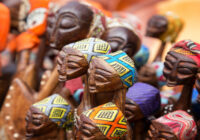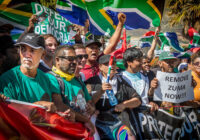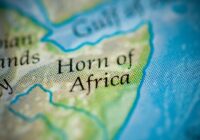Eastern African famine is cause for concern as southern Africa’s bountiful harvests offer hope — as does the containing of an Ebola outbreak in a remote part of the continent.
Much of Africa’s modern story has been told through the lens of fragility, famine and conflict. These three elements still stalk the continent. However, Africa is a sprawling continent with multiple ecosystems and many economies. In the midst of its challenges, Africa also radiates with a groundswell of fierce optimism, a people with extraordinary fortitude and everyday stories of triumph and forward progress. The narrative of the continent as these authors have pointed out from day one is complex with “multitudinous cadences and intricate plots.”
The March edition of Africa This Month pointed out how “climate change, droughts, floods, growing populations, civil strife, slowing economies and flailing states [were] putting lives of millions at risk.” This month that risk has lowered in some parts of the continent considerably, thanks to South Africa’s biggest maize crop in four decades.
A TALE OF TWO EXTREMES IN AFRICA
For the last two years, southern Africa experienced the worst drought in 30 years because of the El Niño weather phenomenon. Crops failed because of lack of water. Food prices rose because falling crop production failed to meet demand. Inflation made it harder for families to put enough food on the table, making life especially difficult for the millions of poor and unemployed.
Thankfully, good rains in January and February have helped. They did cause floods at the time but provided much needed moisture to the parched soil. Now, South African farmers are set to produce over 15 million tons of maize, leaving the country with a 50% surplus for the year. This will push down food prices and, as granaries begin to fill up, the poor will certainly be heaving a sigh of relief.
South African farmers might not do so well though. When supply outstrips demand, prices fall. Of course, South Africa can export maize but a large portion of its produce is white maize, which is consumed largely in Africa and not elsewhere. Besides, maize production in Zambia, Zimbabwe and Malawi has increased this year. This makes competition in the export market stiffer, putting more downward pressure on maize prices. Furthermore, countries like Kenya and Burundi do not allow imports of genetically modified crops, which rules out much of South African corn.
Even as maize production has increased in South Africa, it has decreased in Kenya. In a brilliant article in The Nation, David Ndii points out how Kenyan maize harvest dropped to 37 million bags in 2016 from 41.9 million bags in 2012. At the same time, Kenya’s population increased by 4 million. This means the amount of maize produced per consumer declined by 5% per year, falling from 103 kilograms in 2012 to 82 last year. Naturally, maize prices and the cost of food in Kenya have shot up.
In fact, the falling per capita maize production has forced Kenya to buy maize to feed its people. It has imported 330,000 bags, which have now caused a scandal. Apparently, it “was surplus of old stock in South Africa” and unlikely to be maize from Mexico, as initially claimed by the Kenyan government but apparently denied by the government of Mexico. Many suspected corruption. Within five days of the government lifting its ban on the import of maize, a ship arrived on Kenyan shores purportedly filled with maize coming all the way from Mexico. Naturally, such a narrative is not entirely convincing even to the government’s sympathizers.
Intrigues are magnifying in the maize importation saga because Kenya’s general election is coming up fast. With just over two months to go, the government’s highest priority is re-election. Therefore, it has a natural incentive to subsidize essential commodities such as maize. After all, higher prices of staple foods have never endeared any government to the voters. Of course, the opposition has an incentive to convince voters that the government is incompetent. Therefore, it is painting a picture of unabated corruption and gross mismanagement on the part of the government.
 Ndii, who is serving on the opposition’s technical and strategy committee, has damned the government for poor economic decision-making. For him, the financing of the maize purchase is dodgy, the purchase itself is fiscally irresponsible, and the government’s attempt to subsidize maize laughably ineffective because it is ending up on the black market.
Ndii, who is serving on the opposition’s technical and strategy committee, has damned the government for poor economic decision-making. For him, the financing of the maize purchase is dodgy, the purchase itself is fiscally irresponsible, and the government’s attempt to subsidize maize laughably ineffective because it is ending up on the black market.
Kenya is not alone in suffering from a shortage of maize. In eastern Africa, 17 million may be facing hunger because of food shortages and rising prices. Overflowing silos and rotting crops in the south starkly contrast with barren fields and empty kitchens in the east. This tale of two extremes reveals how weather still plays such a big role in African agriculture and the continent’s economy.
EBOLA STRIKES BACK
From 2014 to 2016, the World Health Organization (WHO) declared a public health emergency regarding Ebola. It was a response to an epidemic in which Ebola killed more than 11,300 people and infected some 28,600. Starting in 2013, Ebola swept through the West African countries of Guinea, Sierra Leone and Liberia, causing alarm around the world. In June 2016, the WHO declared Liberia free of Ebola. Other countries had beaten back the epidemic earlier. This month, Ebola is back.
The WHO confirmed one death because of Ebola and is investigating two more that might have died because of the virus. A total of nine people reportedly contracted the virus. The latest Ebola outbreak affects a remote northern forested zone of the Democratic Republic of Congo (DRC), 1,300 kilometers north of the capital, Kinshasa. As per the United States Agency for International Development (USAID), about 70% of people in DRC have little or no access to health care. Conflict-ridden DRC has one of the world’s least equipped health care systems, which could be sorely tested if an outbreak occurs.
Thankfully, a prototype vaccine has proven to be “very effective” against the deadly Ebola virus. Gavi, the vaccine alliance, has announced that the 300,000 doses of this experimental vaccine will be “available if needed to stop this outbreak becoming a pandemic.” The DRC has approved the use of this experimental vaccine. However, if the epidemic was to spread in the remote parts of the DRC, delivering the vaccine to affected areas might not be a straightforward undertaking.
The remoteness of the location of the outbreak is “a mixed blessing.” Population movement into and from this area is not significant unlike the earlier case of West Africa. Hence, the rapid expansion of Ebola to other localities is unlikely. It is true that surveillance or investigations in this area are difficult, but its relative isolation makes the outbreak a largely local matter as of now.
The WHO is optimistic about controlling the Ebola outbreak. Last time, the organization came in for sharp criticism. However, it appears to have learnt its lesson and has acted with greater alacrity this time around. Matshidiso Moeti, the first woman to be the WHO regional director for Africa, is leading a reform process to transform the WHO in the African Region into a “more responsive, accountable, effective and transparent organization.” Judging by the WHO response to the DRC outbreak, her efforts seem to be bearing fruit.
WHO ELECTS AN AFRICAN TO TOP JOB
Speaking of the WHO, on May 23, Ethiopia’s Tedros Adhanom Ghebreyesus became the first African to head the organization. He is also the first non-physician to head the global health body. In the third round, he finally beat David Nabarro of the United Kingdom to the job and declared, “All roads lead to universal coverage.” Adhanom has declared this to be his central priority. In his words, “only about a half of the world’s people have access to healthcare without impoverishment.” Expanding this access is what Adhanom aims to do.
Despite his upbeat declarations, Ethiopia’s former health minister remains a controversial figure. Olympic silver medalist Feyisa Lilesa accuses the new WHO boss of hypocrisy. Lilesa says that while Adhanom was touring the world and talking of health as a human right, “his office refused to acknowledge large cholera outbreaks which cost many lives.” The athlete goes on to damn Adhanom’s track record as minister, claiming it was hyped up and was little more than “a coercive political recruitment tool” for the ruling party.
Exiled Lilesa hails from the Oromia region, the largest of Ethiopia’s nine ethnic-based states. He laments “the killings, imprisonment and harassment of my people by Ethiopian security forces.” Lilesa called Adhanom “one of the chief architects of Ethiopia’s repressive regime.” He accuses the regime of “systematically [decimating] domestic opposition, the civil society and independent press,” as well as “attempting to intimidate and silence critics abroad.” For Lilesa, “after years of authoritarian backsliding, Ethiopia is now effectively a military state.”
It seems the 50 African states and other countries did not pay much heed to Lilesa. In any case, this is the first time the WHO boss is being selected through election. Adhanom might be a controversial figure, but Africans like the symbolism of their man as the head of an organization that matters enormously to their wellbeing.
Adhanom will have his work cut out at the WHO. Al Jazeera reports: “[The WHO’s] spending on travel exceeded its expenditure on public health problems.” Apparently, staff at the WHO like their five-star hotels and business-class plane tickets. This makes fundraising difficult because many have lost trust in this United Nations organization. Hence, the WHO is struggling to raise $100 million and $136 million for Somalia and Yemen respectively. Adhanom’s first task is to go beyond platitudes of health as a human right and restore the credibility of his beleaguered organization.
ETHIOPIA BECOMES EAST AFRICA’S BIGGEST ECONOMY
Africa News reports that Ethiopia has officially overtaken Kenya as the largest economy in East Africa. Since 2015, Ethiopia has been growing at a staggering 10.8%. Public spending on infrastructure, strong local demand and Chinese investment are the key drivers of Ethiopian growth. Even as critics like Lilesa damn Ethiopia’s regime, it is making big effort to modernize the country’s economy.
The Ethiopian government is investing in roads, railways and power plants. In the words of The Economist, Ethiopia now has “Sub-Saharan Africa’s largest mass-housing programme; its first metro; its biggest army.” At the end of 2016, it also inaugurated Africa’s tallest hydroelectric dam that towers at 243 meters above the Omo River. Now, Ethiopia is inching closer to the completion of the largest-ever dam in Africa: the Grand Ethiopian Renaissance Dam on the Blue Nile.
This dam alone will produce as much energy as the whole of neighboring Kenya, which has signed up already to buy some of its power. So have Sudan, Tanzania and Djibouti. Cheap power might also boost the infant manufacturing sector that the Ethiopian regime is obsessed about. In 2016, an electric railway line opened that connected Addis Ababa, Ethiopia’s capital, to Djibouti, a port nation on the Red Sea. Now, this landlocked country finally has an outlet to the sea. Not to be completely outdone, this month, Kenya launched a standard gauge railway line from the port city of Mombasa to its capital city of Nairobi. It remains to be seen if this initiative will spur enough economic growth in the country to challenge Ethiopia for the relinquished top-economy spot.
Ethiopia’s impressive development of infrastructure has been enabled by funding and expertise from China. A Chinese bank invested $3.4 billion into the railway. A Chinese loan of $470 million has enabled the construction of the world’s largest dam. China’s engineers and workers not only built the railway, but will also manage the trains for the next five years. The Chinese are building roads, telecommunications and the much-celebrated light rail system in Addis Ababa. Naturally, they are also helping with the dams. More importantly, the Chinese are assisting the Ethiopian government to build six industrial parks in the next few years.
Not all Ethiopians are happy with increased Chinese involvement in their country. Dee Abdella argues that “Ethiopia is on a path to become Africa’s China in more ways than one.” Annual Sino-Ethiopian trade exceeds $3 billion, and the Middle Kingdom has invested more than $20 billion in Ethiopia already. Abdella argues that countries march on toward economic growth with little regard to human rights or civil liberties. Her words echo Lilesa: “Ethiopia daily violates the political and civil rights of its citizens by denying them the basic freedoms of speech, association and assembly.”
The Economist quotes a 2014 Oxford University study on big dams which argued that they tend to damage developing economies because they saddle them with debt. Besides, they offer scant benefits to the populations they displace. Ethiopia’s dams will affect millions that live downstream and who were never consulted about them. They are also changing ecosystems dramatically. River Omo ends in Lake Turkana in Kenya, where water levels are dropping fast. Some fear the lake itself could disappear one day.
To boost productivity, the Ethiopian government is “resettling semi-nomadic cattle herders from the Lower Omo basin into permanent villages along irrigated canals.” This is part of the government’s highly controversial “villagization” program. Officials often promise “land, livestock, clean water, a corn grinder, education and a health clinic,” but villagers tend to encounter dense vegetation and tough conditions where they are expected to make a hardscrabble living.
Ethiopia might be growing fast, but it presents all the perils of such growth. Other African countries could do well to take note.
The views expressed in this article are the author’s own and do not necessarily reflect Fair Observer’s editorial policy.
Photo Credit: Ilonde
Support Fair Observer
We rely on your support for our independence, diversity and quality.
For more than 10 years, Fair Observer has been free, fair and independent. No billionaire owns us, no advertisers control us. We are a reader-supported nonprofit. Unlike many other publications, we keep our content free for readers regardless of where they live or whether they can afford to pay. We have no paywalls and no ads.
In the post-truth era of fake news, echo chambers and filter bubbles, we publish a plurality of perspectives from around the world. Anyone can publish with us, but everyone goes through a rigorous editorial process. So, you get fact-checked, well-reasoned content instead of noise.
We publish 2,500+ voices from 90+ countries. We also conduct education and training programs
on subjects ranging from digital media and journalism to writing and critical thinking. This
doesn’t come cheap. Servers, editors, trainers and web developers cost
money.
Please consider supporting us on a regular basis as a recurring donor or a
sustaining member.
Will you support FO’s journalism?
We rely on your support for our independence, diversity and quality.






